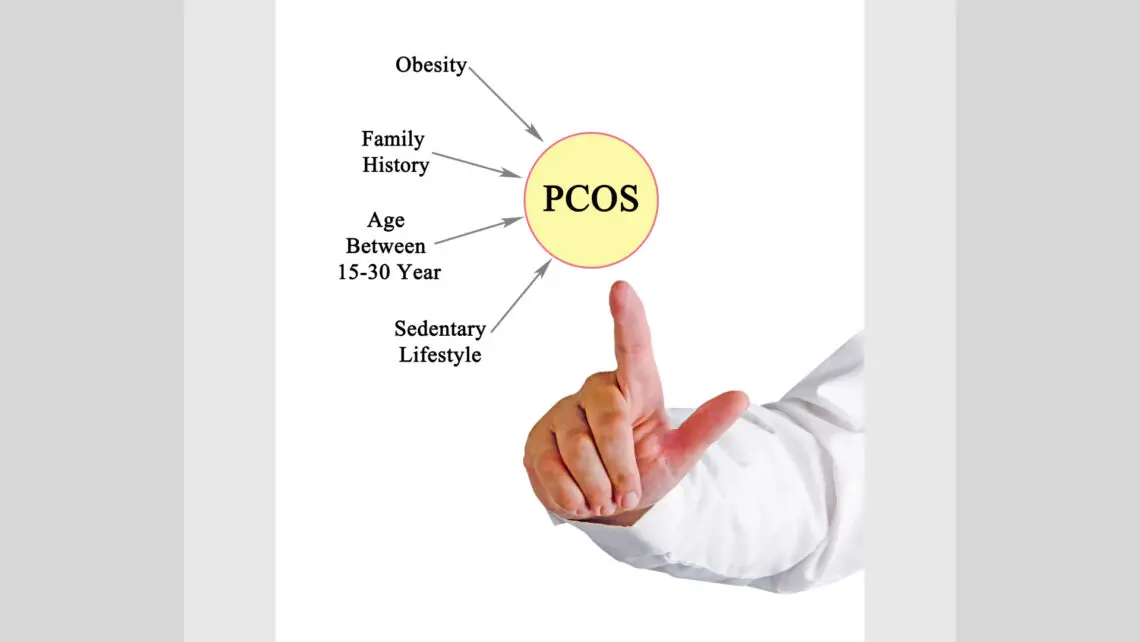Abstract
An 18-year old girl diagnosed with polycystic ovarian syndrome and fibroadenoma of right breast consulted for irregularity of menstruation and lump in right breast on 07/09/15. After Homoeopathic case taking, she was prescribed Calcarea carbonicum in ascending LM potencies. Her menstruation regularized within 16 weeks of treatment. Other symptoms such as anxiety, depression, oiliness of face, abnormal growth of facial hair, and body weight reduced together with disappearance of a lump in her right breast, improving her quality of life. The investigations repeated after 4 months showed complete resolution of ovarian cysts.
Key words
Polycystic Ovarian Syndrome; Calcarea carbonicum
Introduction
PCOS is now recognized as the most common endocrinopathy in reproductive-aged women with key features of menstrual irregularity, elevated androgens, and polycystic-appearing ovaries. Increased production or sensitivity to androgens commonly leads to hirsutism (male-patterned hair growth), acne, or alopecia (thinning or loss of scalp hair). Adolescent patients pose particular diagnostic problems because characteristics of normal puberty often overlap with signs and symptoms of PCOS.
PCOS Diagnostic Criteria for Adolesents
| PCOS Definition | Clinical Hyperandrogenism
(Ferriman-Gallwey Score ≥ 8) or Biochemical Hyperandrogenism (Elevated Total/Free Testosterone) |
Oligomenorrhea
(Less than 6-9 Menses per Year) or Oligo-Ovulation |
Polycystic Ovaries on Ultrasound (≥ 12 Antral Follicles in One Ovary or Ovarian Volume ≥ 10 cm3) |
| NICHD (1990) | Yes | Yes | No |
| Rotterdam (2003) | Yes | Yes | Yes |
| 2 of 3 criteria | |||
| AE-PCOS Society
(2009) |
Yes | Yes | Yes |
| 1 of 2 criteria | |||
This is a case report of Homoeopathic treatment of an 18-year old girl for four months suffering with PCOS and fibroadenoma of right breast.
Case Report
Patient information
| Name | Age | Sex | Religion | Address | Marital status | Occupation |
| T. P | 18 years | F | Hindu | Kaliachak, Malda, West Bengal | Married | Student |
Patient was tall, thin, fair complexioned, dark eyed, with acne and abnormal growths of hair on oily face. She consulted me on 07-09-2015 for the following complaints:
- Irregularity of menses for 4 years, occurring at an interval of 4 to 5 months; flow was profuse, with occasional clots, and severe pain in lower abdomen.
- Lump in the right breast for 3 years.
History of present complaints:
Her complaints started 4 years back. She gradually gained weight. Acne appeared on her face. Her face became oily and regularity of menses was altered. She was regularly taking allopathic medicine from a gynecologist for the last 3 years, before coming to me. She also developed a lump in her right breast 3 years ago, and was advised lumpectomy by a surgeon.
Past History
Nothing significant
Family History
Nothing significant
Personal History
Married; College going student
General Symptoms
Physical Generals
| Appetite | Good. But cannot tolerate hunger |
| Desire | Sour, meat, cold food |
| Aversion | Bread |
| Intolerance | Milk and rich food causes indigestion |
| Thirst | Profuse; 4 litres/ day; thirst for large quantities of water |
| Tongue | Clean, moist, flabby, indented |
| Breath | offensive |
| Salivation | salivation off and on |
| Sleep | Sound; sleeps on right or left lateral position |
| Dreams | Lascivious |
| Sweat | Scanty, non-offensive, especially on face and chest; feels better after sweating. |
| Stool | Unsatisfactory; twice a day; hard stool followed by soft stool; offensive; first stool of the day after taking tea or water. |
| Urine | Clear |
| Menses | Irregular; occurring at an interval of 4 to 5 months; profuse flow; with occasional clots and severe pain in lower abdomen. |
| Thermal Reaction | Hot patient; prefers winter season |
| General Tendency | Catches cold easily |
Mental Generals
She was also a college going student and her academic performance deteriorated due to depression and anxiety about the future. She could not do her household work for the same reason.
She was mild, timid and slow. She repeatedly emphasized throughout the consultation that she had an incurable disease which may convert into cancer in the future. She used to become uncomfortable if anyone in her surroundings or among relatives or known persons suffering with cancer dies.
Analysis and evaluation of symptoms
| Mental generals | Fear of Cancer
Fear of impending incurable disease Sad events affect her profoundly Aversion to business Doubtful of recovery Timidity and bashful Curious Mildness Slowness |
| Physical generals | Desires sour food, meat and cold food
Intolerance of milk Tongue: indented Thirst for large quantities of water Sweat scanty Stool hard followed by soft stool Tendency to take cold easily Hot patient |
| Particulars | Tumour in right breast |
Totality of symptoms and conversation of symptoms into rubrics
| Symptoms | Rubrics |
| Fear of Cancer | Mind: Fear, Cancer of |
| Fear of impending incurable disease | Mind: Fear, disease of impending, incurable, of being |
| Sad events affect her profoundly | Mind: Horrible things, sad stories affect her profoundly |
| Aversion to business | Mind: Business; aversion to |
| Doubtful of recovery | Mind: Doubtful recovery of |
| Timidity and bashful | Mind: Timidity, bashful |
| Desires sour food, meat and cold food | Generals: Food and drinks, sour food, acid, desires |
| Generals: Food and drinks, meat, desires | |
| Generals: Food and drinks, cold food, desires | |
| Intolerance of milk | Generals: Food and drinks, milk agg. |
| Tongue: indented | Mouth: Indented, tongue |
| Thirst for large quantities of water | Stomach: Thirst, large quantities, for |
| Sweat scanty | Perspiration: Scanty, sweat |
| Stool hard followed by soft stool | Stool: Hard, followed by, soft stool |
Repertorization of the case
The symptoms of the patients have been analysed as per Kentian method of evaluation into mental generals, physical generals and particular symptoms.
The case has been repertorized using RADAR 10.5.003 Software (Figure: 4) based on Synthesis 9.0 by F. Schroyens, following Kentian method of Repertorisation method and Total addition process.
Calcarea carbonicum was finally selected after consulting materia medica.
Intervention
Calcarea carbonicum in 0/1 potency was prescribed in 16 doses to be taken every morning vac ven. and after 16 days, Calcarea carbonicum in 0/2 potency was to taken in same way.
Follow-Up of the case
| Date | Indications for prescription | Medicine |
| 04/10/15 | Menses did not appear
Breast lump slightly reduced in size Acne, oiliness of face, abnormal growth of hair on face were same as before Anxiety and depression slightly improved Weight: 64 kg; same as before |
Calc. carb. 0/3, 16 doses, OD, vac ven followed by Calc. carb. 0/4, 16 doses, OD, vac ven |
| 01/11/15 | Menses appeared on 20/09/15 and was continuing till 01/11/15
Menses profuse; with occasional clots with severe pain in lower abdomen Breast lump slightly more reduced in size Anxiety and depression markedly improved Acne, oiliness of face is slightly reduced Abnormal growths of hair on face same as before Weight: 63 kg; slightly reduced |
Calc. carb. 0/5, 16 doses, OD, vac ven followed by Calc. carb. 0/6, 16 doses, OD, vac ven |
| 29/11/15 | Menses ceased on 06/11/15
Breast lump disappeared Anxiety and depression markedly improved Acne, oiliness of face much more reduced Abnormal growths of hair on face were same as before Weight: 62 kg Patient was doing well; no new complaints; So patient was advised for USG lower abdomen and breast mammograph. |
Calc. carb. 0/7, 16 doses, OD, vac ven followed by Calc. carb. 0/8, 16 doses, OD, vac ven |
| 27/12/15 | Menses appeared on 25/12/16
Menstrual flow was normal; with slight pain in lower abdomen Breast lump disappeared Anxiety and depression no more Acne and oiliness of face no more Abnormal growth of hairs on face slightly reduced Weight: 62kg; same as before Patient came with USG Pelvis dated 21/12/15 showing normal study. She was unwilling to undergo breast mammograph. |
Calc. carb. 0/9, 16 doses, OD, vac ven followed by Calc. carb. 0/10, 16 doses, OD, vac ven |
Conclusion
This is a single case report of PCOS resolved by homoeopathic treatment. The homoeopathic similimum cures the case. More case reports clinical trials and RCTS on PCOS are needed to define the scope of homoeopathy in treatment of PCOS.
Financial support and sponsorship
Nil.
Conflict of interest
None declared.
References:
- Roe AH., Dokras A. The diagnosis of polycystic ovary syndrome in adolescents. Rev Obstet Gynecolv.4(2); Summer 2011. Available from: https://www.ncbi.nlm.nih.gov/pmc/articles/PMC3218544/ [Accessed 9th Sep 2017]
- Androgen Excess and PCOS Society. Polycystic Ovary Syndrome. Available from: http://www.ae-society.org/ [Accessed 9th Sep 2017]
- Schroyens F. Radar software, version 10.0; © Archibel 2007, Belgium
Address for correspondence
Dr.Sandeep Karmakar, Near Truck Stand, Shakuntala park (Ghorapir); P.O. Rathbari; Dist: Malda-732101, West Bengal
Email: [email protected]










Excellent explanation